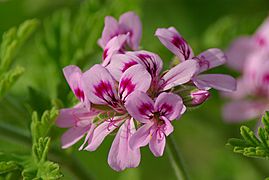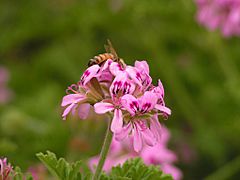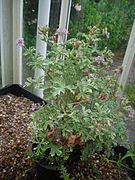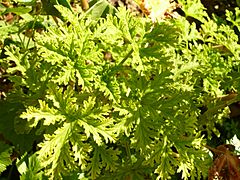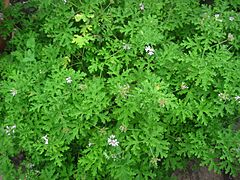Pelargonium graveolens facts for kids
Quick facts for kids Pelargonium graveolens |
|
|---|---|
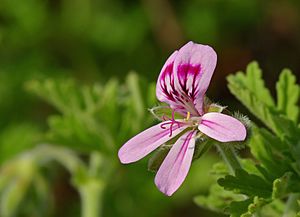 |
|
| Scientific classification | |
| Genus: |
Pelargonium
|
| Species: |
graveolens
|
Pelargonium graveolens is a type of plant known as a Pelargonium. It grows naturally in parts of South Africa, Zimbabwe, and Mozambique. People often call it the rose geranium because of its lovely scent.
Contents
What's in a Name?
The name Pelargonium comes from an old Greek word, pelargos, which means "stork." This is because the plant's fruit looks a bit like a stork's bill! The second part of its name, graveolens, means "strong-smelling." This refers to the plant's leaves, which have a very noticeable smell.
Plant Description
The rose geranium is a bushy plant that stands upright. It can grow up to 1.5 meters (about 5 feet) tall and spread out about 1 meter (about 3 feet) wide. Its leaves are soft and feel like velvet because they have tiny hairs. The leaves are also deeply cut, almost like fingers.
The flowers of this plant can be light pink or almost white. They usually bloom from August to January. While many rose geraniums smell strongly of roses, some have a different scent or even very little scent at all. The shape of the leaves can also be a bit different from one plant to another.
Common Names
This plant has many common names. Some people call it rose geranium, sweet scented geranium, or old fashion rose geranium. It's important to know that even though it's called a "geranium," it's actually a Pelargonium. Both belong to the same plant family, Geraniaceae.
Different Types of Rose Geraniums
Many rose geranium plants you see are not exactly like the ones found in the wild. They are often hybrids, which means they are a mix of different Pelargonium types. These special plants are called cultivars. They have been grown to have many different scents.
Popular Cultivars
- P. 'Graveolens' (or Pelargonium graveolens hort.): This is a popular rose-scented type. It might be a mix of P. graveolens and other Pelargonium species. Its leaves are more deeply cut than the wild plant.
- P. 'Citrosum' (also known as Pelargonium 'Citrosum'): This one smells like lemon and citronella. Some people think it can keep mosquitoes away.
- P. 'Cinnamon Rose: As you might guess, this cultivar smells like cinnamon!
- P. 'Lady Plymouth: This is a very popular type that smells like mint and lemon, with a hint of rose.
- P. 'Mint Rose: Similar to 'Lady Plymouth', this one has a minty rose scent but without the varied leaf colors.
- P. 'Secret Love: This is a unique type that smells like eucalyptus and has light pink flowers.
There are many other cultivars with scents like citrus, mint, and even various fruits.
How People Use Rose Geranium
The rose geranium is very important in the perfume industry. Its leaves are used to make "geranium oil." This oil is often used in aromatherapy and massage therapy. It can also be used to make more expensive rose oils smell even better.
Besides perfumes, the flowers and leaves are used to add flavor to food. You might find them in cakes, jams, jellies, ice creams, and even teas. Some people also use them to flavor pipe tobacco.
What Makes Geranium Oil Smell Good?
Scientists have found over 50 different natural chemicals in geranium oil. The main ones that give it its special smell are called citronellol, nerol, and geraniol. These chemicals are what make the oil smell so pleasant and unique.
Gallery
See also
 In Spanish: Pelargonium graveolens para niños
In Spanish: Pelargonium graveolens para niños


